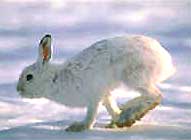

 It's a fact of basic physics that a body loses most of it's heat near its surface. It happens that of all geometrical forms, the one with the least surface area relative to its total volume, is the sphere.
It's a fact of basic physics that a body loses most of it's heat near its surface. It happens that of all geometrical forms, the one with the least surface area relative to its total volume, is the sphere.
 This means that if you live in a cold climate and want to be warm, you will find a certain advantage in being somewhat spherical -- being short and thick. The Black-tailed Jackrabbit at the left and the Arctic Hare at the upper right clearly take advantage of this phenomenon. The Black-tailed Jackrabbit, a resident of hot, arid areas, has long ears, long legs and a longish head. The Arctic Hare's ears are much shorter relative to its head size, plus the head itself is more spherical, and the legs are relatively shorter than the Black-tailed Jackrabbit's.
This means that if you live in a cold climate and want to be warm, you will find a certain advantage in being somewhat spherical -- being short and thick. The Black-tailed Jackrabbit at the left and the Arctic Hare at the upper right clearly take advantage of this phenomenon. The Black-tailed Jackrabbit, a resident of hot, arid areas, has long ears, long legs and a longish head. The Arctic Hare's ears are much shorter relative to its head size, plus the head itself is more spherical, and the legs are relatively shorter than the Black-tailed Jackrabbit's.
Seeing such facts repeated again and again among many species, in 1877 American zoologist Joel Asaph Allen published his findings that among geographical races of single species, certain extremities of animals are relatively shorter in the cooler parts of a species' range than in the warmer parts. By "extremities" is mainly meant arms, legs, ears, and snout or nose. Allen's claims were accepted by the scientific community, so today ecology students are taught about Allen's Rule. There are many more of Nature's rules and laws to consider, too.
It's also a matter of basic physics that the larger a sphere, the less is its surface area relative to its total volume. Therefore, large balls lose heat more slowly, relative to their size, than small ones. You might guess, then, that animals tend to be larger in cold areas than in tropical ones. In fact, Bergmann's Rule asserts that geographic races of a species possessing smaller body size are found in the warmer parts of the range, and races of larger body size in cooler parts.  If you're familiar with the bushy-tailed, roly-poly Raccoons of northern North America, you'll see Bergmann's Rule expressed in the relatively lanky, slender-tailed look of the Raccoon at the left -- same species as up north -- photographed in tropical Yucatan, Mexico.
If you're familiar with the bushy-tailed, roly-poly Raccoons of northern North America, you'll see Bergmann's Rule expressed in the relatively lanky, slender-tailed look of the Raccoon at the left -- same species as up north -- photographed in tropical Yucatan, Mexico.
Turning from spheres, Gloger's Rule states that dark pigments increase in races of animals living in warm and humid habitats. Of course, among the animal species supporting this "rule" is humankind.
Gause's Law, or the "competitive exclusion principle," states that two species competing for the same resource can't coexist at constant population levels. Competition between the two species leads either to the extinction of the weaker competitor, or to an evolutionary or behavioral shift in either or both species, so that they begin to exploit at least somewhat different ecological niches.
With special reference to birds in the Northern Hemisphere, the Egg Rule states that the average number of eggs in a set, or clutch, laid by songbirds and several other kinds of birds, increases as one moves north in latitude. This state of affairs probably evolved to balance the fact that in the north songbirds may be able to raise only one brood per season, while farther south, two, three, or more broods may be possible.
We all know that "breaking rules or laws" can get us in trouble. When humanity behaves in ways not taking into account ecological rules and laws, only trouble can result.
Other ecological rules and laws are described on Wikipedia's Biological rules page.